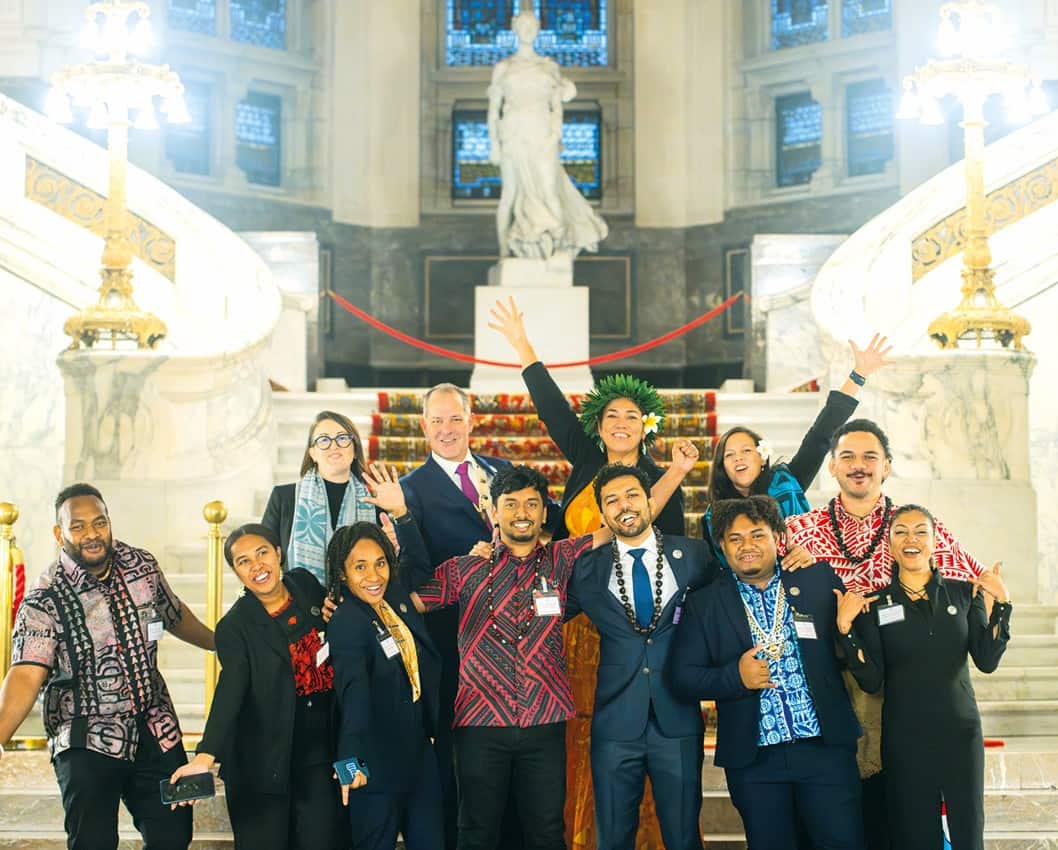Copyright islandsbusiness

The ocean connects the islands of the Pacific rather than separates them. It is their blue continent, theirhighway, their lifeblood. But now, that same ocean is rising, and threatening to swallow the very shoresit once nurtured. In the face of this existential threat, the Pacific Community (SPC) has launched its Climate Change Flagship (CCF), a modern-day Vaka—a great canoe—built not from timber, but from unity, science, Pacific knowledge, and an unwavering resolve to navigate the storm and despite the head winds of climate change, leverage resilience and prosperity. This is not just another strategy document. It is a covenant, a promise to the people of the BluePacific Continent. It’s a promise that their voices, steeped in generations of traditional knowledge andlived experience, will not be drowned out by global indecision. It’s a promise that the unique challenges of watching your ancestral land disappear will be met with more than sympathy – with tangible, scaled-upaction, and access to the finance that islands have been promised. “Indigenous knowledge, traditional practices and cultures are still very much lived and vibrant here,”explains Coral Pasisi, Director of the SPC’s Climate Change and Sustainability team. “It comes from aposition of authority and lived reality; it is an applied science. It is one of the most predominant sources of information to tell how your environment is changing, it was just verified in a different way to modern science.” For Pasisi, this isn’t theoretical. It’s personal and lived. The SPC Climate Change Flagship work must be a vessel that carries this collective capability and wisdom forward, ensuring that the measures taken to save Pacific nations are shaped not only Pacific hearts and minds but by their pooled capability and public goods and services. She stresses the importance of Pacific-led and owned priorities and actions: “We need to make sure that the goalposts are set from the right perspective. If they are setby other people, what is seen as a success from their perception is not necessarily a success when seen from a Pasifika lens of interest.” How the Climate Change Flagship is breaking down barriers into an integrated way of workingThe voyage is mapped across four action dimensions: helping communities adapt to the changes already upon them; guiding mitigation and a just transition to decarbonisation; addressing the heartbreaking reality of loss and damage and climate security; and finally, unlocking the climate finance needed tomake it all possible. The gap between what is needed and what is provided is a chasm. Pacific Island countries are conservatively assessed at needing approximately $US2 billion annually to address climate action. They receive a mere $US330 million – a devastating shortfall, and mere 0.33% of what the global family promised. This lack of adequate finance upfront, results in higher costs of loss and damage down the track. But the Vaka is already catching the wind. In its first two years, this One SPC Climate Change flagship has directly secured about US$30 million in anchor investments from partners including the governments of New Zealand Australia, and the Denmark. Thankfully, this initial capital has helped build the crew and strengthen the hull, front-loading SPC’s capability to navigate and leverage the complex seas of international finance to support its members. This capability has, helped secure an approved project pipeline of about $US230 million in Green Climate Fund and Adaptation Fund projects for Pacific Island Countries, with another $US187 million in development for Pacific Island Countries and Territories. This is finance that is already being steered towards critical sectors like fisheries, coastal resilience, health, food security, adaptation, and alternative livelihoods, translating promise into action on the ground. Espen Ronneberg, SPC’s Senior Climate Change Adviser, speaks to the hard work happening below deck: translating complex science into powerful advocacy. “Part of our role, in collaboration with One CROP, is to continue to translate science, data and information into tangible negotiation points that respond to the challenges on the ground,” he says. This means ensuring that our world leading science on tuna stock monitoring, together with fisherfolks observed change in fish catches, or a community’s struggle with salinated water wells becomes woven as critical data informing and driving international discussion and policy. The practical challenges are immense. Ronneberg notes the constant need to adapt to the rigid frameworks of international finance: “Sometimes, one has to go back to the drawing board and see what alternatives there might be to the original guidance sought.” This agile, problem-solving approach is central to SPC’s Climate Change work and mission – to tailor solutions to the Pacific context and reducethe amount of financial gymnastics the region has been subjected to for decades in access to climate finance. And this model of integrated ways of working is already delivering concrete results. The Digital Earth Pacific infrastructure established under CCF acts as a digital nervous system for the region, monitoring environmental changes in near real-time with the bonus of a 40-year retrospective vantage point. In Tuvalu, one of the world’s most vulnerable nations, a coastal hazard modelling tool provides a crystal ball, showing likely inundation scenarios so communities can plan. Cuttingedge 3D sea-level rise modelling makes the future terrifyingly visible but also informs the critical investment and action required toaddress those future scenarios – a vital tool for influencing the climate change discourse and relevant international fora. And when the world’s attention turned to the International Court of Justice’s landmark climate opinion, SPC was there supporting its members, providing the scientific anchor to ensure Pacific voices led the arguments in their own way. But a voyage of this scale requires a full fleet, with every hand on deck. “We have to ensure that every part of the community is included in the decision making without leaving anyone behind,” Pasisi insists, highlighting the core principle of SPC’s people-centred development. This inclusive ethos is woven into the very fabric of the initiative, ensuring that climate action strengthens the entire community. “It’s really important for all voices to be heard in order to find a pathway that everyone can live with,” she adds. “If we continue to focus only on the convenience of today, we will do so at the expense of the sustainability of tomorrow. Tomorrow belongs to our young people and future generations; we must not mortgage their rights to a healthy environment.” The Pacific Vaka is sailing. Its course is set toward 2031, guided by the stars of Pacific wisdom enshrined in the 2050 Strategy, at the heart of SPC’s Strategic Plan, and the compass of modern science and a Climate Change Flagship of collaboration and integration. It is a journey of unity, propelled by early investments that are now leveraging a wave of larger change. In spite of the head winds, the crew is resolute and strengthening its engagement with the whole regional architecture to deliver more effectively together. The invitation is open for all who share this vision to come aboard.



